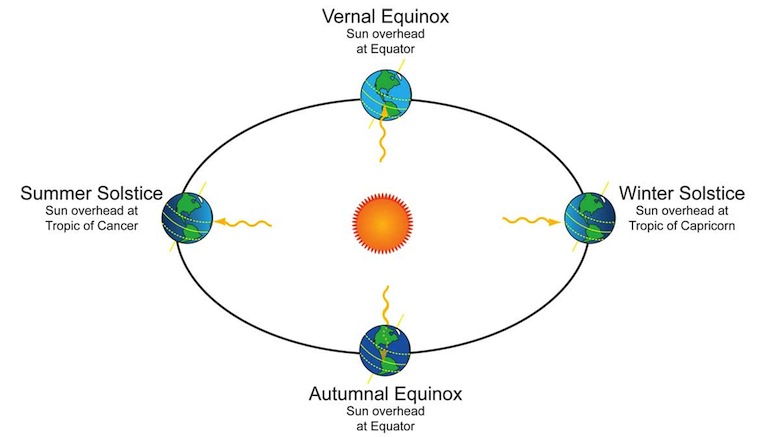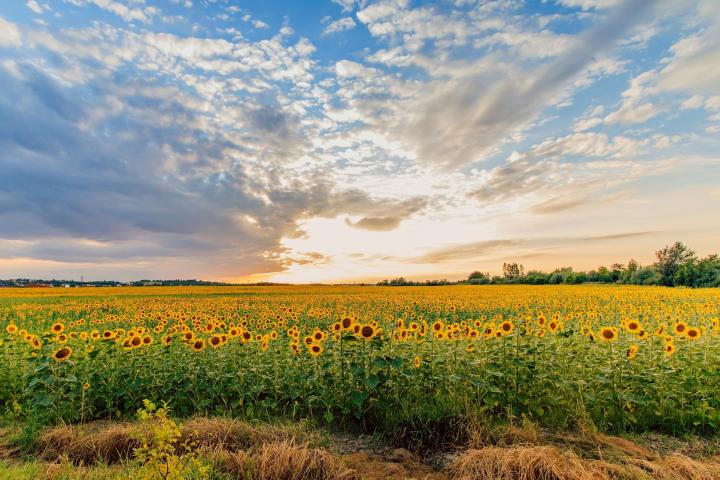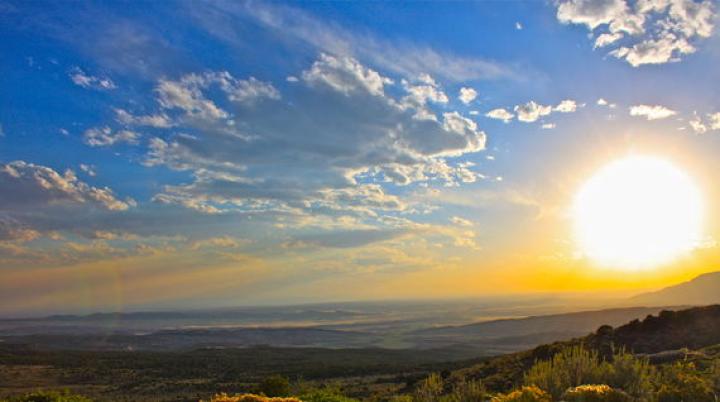Summer Solstice
This year, the June solstice falls on Thursday, June 21, 2018 in all U.S. and Canada time zones, specifically at 6:07 A.M. EDT.
| Year | Summer Solstice (Northern Hemisphere) |
| 2018 | Thursday, June 21 |
| 2019 | Friday, June 21 |
| 2020 | Saturday, June 20 |
WHAT IS THE SUMMER SOLSTICE?
In the Northern Hemisphere, the June solstice occurs when the Sun reaches both its highest and northernmost points in the sky. (In contrast, the June solstice in the Southern Hemisphere is when the Sun is at its lowest point in the sky.)
The word “solstice” comes from Latin solstitium—from sol (Sun) and stitium (standing), reflecting the fact that on the solstice, the Sun appears to stop moving in the sky as it reaches its northern- or southernmost point. After the solstice, the Sun appears to reverse course and head back in the opposite direction.
The timing of the June solstice is not based on a specific calendar date or time; it all depends on when the Sun reaches its northernmost point from the equator. Therefore, the June solstice won’t always occur on the same day.
In temperate regions, we notice that the Sun is higher in the sky throughout the day, and its rays strike Earth at a more direct angle, causing the efficient warming we call summer. Because the sun is highest in the sky on this day, you’ll notice that your shadow (at noon) is the shortest it will be all year.

In the Northern Hemisphere, the summer solstice is the day with the most hours of sunlight of the whole year. See our handy sunrise and sunset calculator to figure out how many hours of sunlight you get in your location on the solstice.
At the winter solstice, just the opposite occurs: The Sun is at its southernmost point and is lowest in the sky. Its rays hit the Northern Hemisphere at an oblique angle, creating the feeble winter sunlight.
See 7 fun facts about the June solstice!
FREQUENTLY ASKED QUESTIONS
Q: IS THE SUMMER SOLSTICE THE FIRST DAY OF SUMMER?
A: Yes and no—it depends on whether we’re speaking meteorologically or astronomically. Most meteorologists divide the year into four seasons based on the months and the temperature cycle, which allows them to compare and organize climate data more easily. In this system, summer begins on June 1 and ends on August 31. Therefore, the summer solstice is not considered to be the first day of summer, meteorologically speaking.
Astronomically, however, the first day of summer is said to be when the Sun reaches its highest point in the sky, which occurs on the summer solstice (June 20–22). Therefore, the summer solstice is considered to be the first day of summer, astronomically speaking.
As an almanac, which is defined as a “calendar of the heavens,” we prefer to follow the astronomical interpretation of the seasons and do consider the first day of summer to coincide with the summer solstice. That being said, you may choose whichever system you like best!

Q: WHY DOESN’T THE SUMMER SOLSTICE FALL ON THE SAME DATE EACH YEAR?
A: The summer solstice in the Northern Hemisphere ranges in date from June 20 to 22. This occurs in part because of the difference between the Gregorian calendar system, which normally has 365 days, and the tropical year (how long it takes Earth to orbit the Sun once), which has about 365.242199 days. To compensate for the missing fraction of days, the Gregorian calendar adds a leap day about every 4 years, which makes the date for summer jump backward. However, the date also changes because of other influences, such as the gravitational pull from the Moon and planets, as well as the slight wobble in Earth’s rotation.
Q: WHY ISN’T THE SUMMER SOLSTICE—THE LONGEST DAY OF THE YEAR—ALSO THE HOTTEST DAY OF THE YEAR?
A: Earth’s atmosphere, land, and oceans absorb part of the incoming energy from the Sun and store it, releasing it back as heat at various rates. Water is slower to heat (or cool) than air or land. At the summer solstice, the Northern Hemisphere receives the most energy (highest intensity) from the Sun due to the angle of sunlight and day length. However, the land and oceans are still relatively cool, due to spring’s temperatures, so the maximum heating effect on air temperature is not felt just yet. Eventually, the land and, especially, oceans will release stored heat from the summer solstice back into the atmosphere. This usually results in the year’s hottest temperatures appearing in late July, August, or later, depending on latitude and other factors. This effect is called seasonal temperature lag.
Q: WHAT IS MIDSUMMER DAY (JUNE 24)?
A: Historically, this day was the midpoint of the growing season, halfway between planting and harvest. Folks celebrated by feasting, dancing, singing, and preparing for the hot summer days ahead. Read more about the ancient Quarter Days!

SOLSTICE FUN FACTS
THE SOLSTICE DOES NOT BRING THE EARLIEST SUNRISE
Interestingly, even though the summer solstice if the “longest” day of the year (the most daylight), the earliest sunrises happen about a week prior to the solstice in the Northern Hemisphere. The reason for the timing of sunrises is related to the length of day—which is longer than 24 hours in June—and the inclination of the Earth’s rotational axis. Bottom-line, your earliest sunrises start happening before the solstice itself.
THE SUN SETS MORE SLOWLY AT THE SOLSTICE
Did you know that the Sun actually sets more slowly around the time of a solstice, in that it takes longer to set below the horizon? This is related to the angle of the setting Sun. The farther the Sun sets from due west along the horizon, the shallower the angle of the setting Sun. (Conversely, it’s faster at or near the equinoxes.) Bottom-line, enjoy those long romantic summertime sunsets at or near the solstice!
SEASONS ON OTHER PLANETS
- Mercury has virtually no tilt (less than ⅓0th of a degree) relative to the plane of its orbit, and therefore does not experience true seasons.
- Uranus is tilted by almost 98 degrees and has seasons that last 21 years.
See sunrise/set times for all the planets!
SOLSTICE TRADITIONS
Every year on the summer solstice, thousands of people travel to Wiltshire, England to Stonehenge—a mysterious prehistoric monument. See more about this ancient site.
In Sweden, people traditionally celebrate the beginning of summer (Midsommar) by eating the first strawberries of the season, lighting bonfires, and dancing around the maypole (midsommarstång). Learn more about Midsummer’s Day.
There are many northern people like the Swedes who celebrate Midsummer’s Day and eve. After all, these northern people have merged from some long, dark winters! In Tyrol, Austria, torches and bonfires are lit up on mountainsides.
According to ancient Latvian legend, Midsummer Even (St. John’s Eve) on June 23 is spent awake by the glow of a bonfire and in pursuit of a magical fern flower—said to bring good luck—before cleansing one’s face in the morning dew. Read more about fern folklore.
In ancient Egypt, summer was the start of the new year. The rising of the star Siriusroughly coincided with the summer solstice and the annual flooding of the Nile River.

SUMMER SOLSTICE FOLKLORE
- Deep snow in winter, tall grain in summer. –Estonian proverb
- When the summer birds take their flight, goes the summer with them.
- If it rains on Midsummer’s Eve, the filbert crops will be spoiled. –Unknown
- One swallow never made a summer.
- Easterly winds from May 19 to the 21 indicate a dry summer.
- If there are many falling stars during a clear summer evening, expect thunder. If there are none, expect fine weather.
- ·
- June 21, 2018 10:54 pm
- June 22, 2018
- ·
- Like

To Achieve The American Dream Remember Your ABCs Acrylic Wall Art by Wanda_Hope_Carter
View more American Acrylic Wall Arts at zazzle.com





.jpg)



